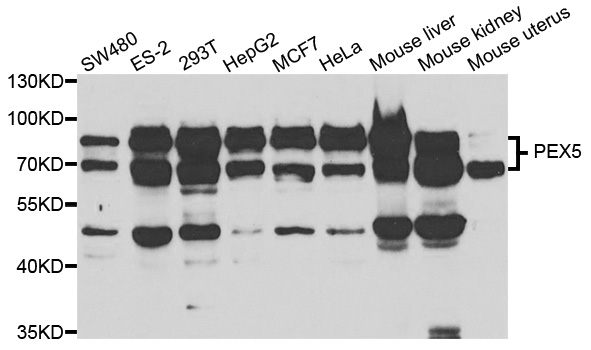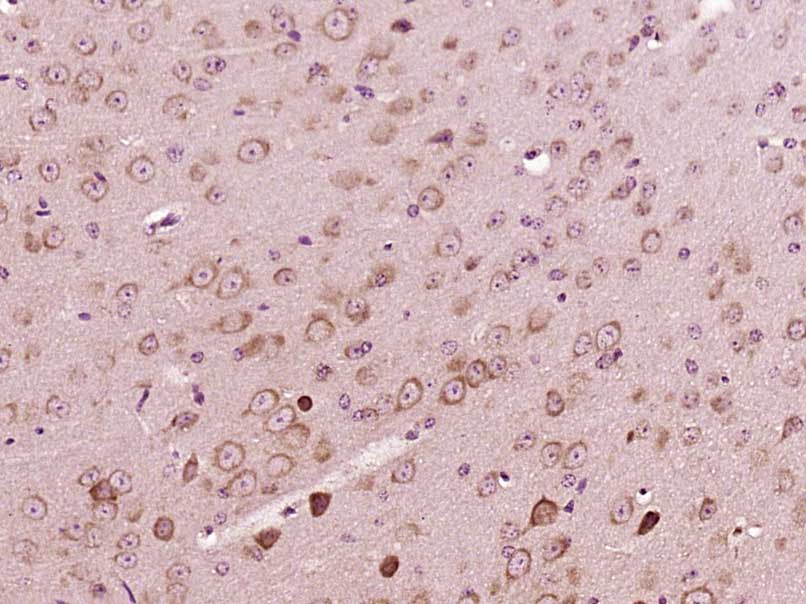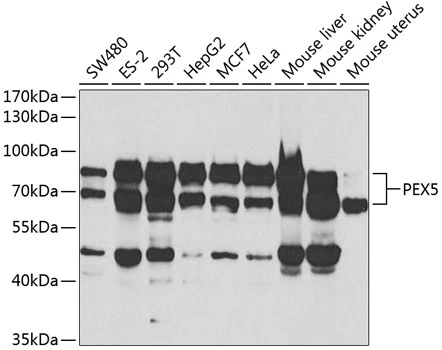PEX5 antibody
GTX109798
ApplicationsWestern Blot, ImmunoHistoChemistry, ImmunoHistoChemistry Paraffin
Product group Antibodies
ReactivityHuman, Mouse
TargetPEX5
Overview
- SupplierGeneTex
- Product NamePEX5 antibody
- Delivery Days Customer9
- Application Supplier NoteWB: 1:1000-1:10000. IHC-P: 1:100-1:1000. *Optimal dilutions/concentrations should be determined by the researcher.Not tested in other applications.
- ApplicationsWestern Blot, ImmunoHistoChemistry, ImmunoHistoChemistry Paraffin
- CertificationResearch Use Only
- ClonalityPolyclonal
- Concentration1 mg/ml
- ConjugateUnconjugated
- Gene ID5830
- Target namePEX5
- Target descriptionperoxisomal biogenesis factor 5
- Target synonymsPBD2A, PBD2B, PTS1-BP, PTS1R, PXR1, RCDP5, peroxisomal biogenesis factor 5, PTS1 receptor, peroxin-5, peroxisomal C-terminal targeting signal import receptor, peroxisomal import receptor 5, peroxisomal targeting signal 1 (SKL type) receptor, peroxisomal targeting signal 1 receptor, peroxisomal targeting signal import receptor, peroxisomal targeting signal receptor 1, peroxisome receptor 1
- HostRabbit
- IsotypeIgG
- Protein IDP50542
- Protein NamePeroxisomal targeting signal 1 receptor
- Scientific DescriptionThe product of this gene binds to the C-terminal PTS1-type tripeptide peroxisomal targeting signal (SKL-type) and plays an essential role in peroxisomal protein import. Peroxins (PEXs) are proteins that are essential for the assembly of functional peroxisomes. The peroxisome biogenesis disorders (PBDs) are a group of genetically heterogeneous autosomal recessive, lethal diseases characterized by multiple defects in peroxisome function. The peroxisomal biogenesis disorders are a heterogeneous group with at least 14 complementation groups and with more than 1 phenotype being observed in cases falling into particular complementation groups. Although the clinical features of PBD patients vary, cells from all PBD patients exhibit a defect in the import of one or more classes of peroxisomal matrix proteins into the organelle. Defects in this gene are a cause of neonatal adrenoleukodystrophy (NALD), a cause of Zellweger syndrome (ZWS) as well as may be a cause of infantile Refsum disease (IRD). Alternatively spliced transcript variants encoding different isoforms have been identified. [provided by RefSeq]
- ReactivityHuman, Mouse
- Storage Instruction-20°C or -80°C,2°C to 8°C
- UNSPSC12352203
References
- Lee SA, Lee J, Kim K, et al. The Peroxisomal Localization of Hsd17b4 Is Regulated by Its Interaction with Phosphatidylserine. Mol Cells. 2021,44(4):214-222. doi: 10.14348/molcells.2021.2217Read this paper
- Mu Y, Maharjan Y, Kumar Dutta R, et al. Pharmacological inhibition of catalase induces peroxisome leakage and suppression of LPS induced inflammatory response in Raw 264.7 cell. PLoS One. 2021,16(2):e0245799. doi: 10.1371/journal.pone.0245799Read this paper
- Eun SY, Lee JN, Nam IK, et al. PEX5 regulates autophagy via the mTORC1-TFEB axis during starvation. Exp Mol Med. 2018,50(4):1-12. doi: 10.1038/s12276-017-0007-8Read this paper
- Mizuno Y, Ninomiya Y, Nakachi Y, et al. Tysnd1 deficiency in mice interferes with the peroxisomal localization of PTS2 enzymes, causing lipid metabolic abnormalities and male infertility. PLoS Genet. 2013,9(2):e1003286. doi: 10.1371/journal.pgen.1003286Read this paper





![FACS analysis of HEK293T cells transfected with either PEX5 plasmid(Red) or empty vector control plasmid(Blue) using GTX83905 PEX5 antibody [6E9].](https://www.genetex.com/upload/website/prouct_img/normal/GTX83905/GTX83905_232_FACS_w_23061420_809.webp)
![WB analysis of HEK293T cells transfected with PEX5 plasmid (Right) or empty vector (Left) for 48 hrs using GTX83908 PEX5 antibody [1D3]. Loading : 5 ug per lane](https://www.genetex.com/upload/website/prouct_img/normal/GTX83908/GTX83908_3989_WB_w_23061420_553.webp)

